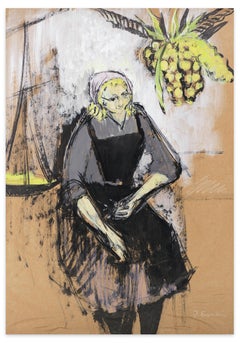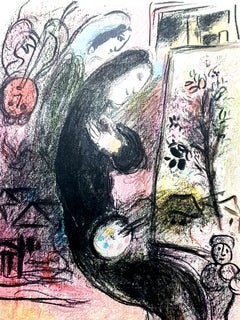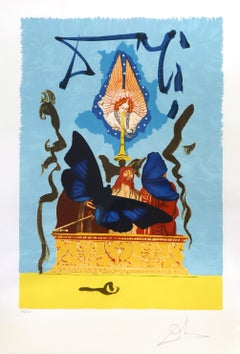Jeanne Esmein Art
to
1
1
Overall Width
to
Overall Height
to
2
1
1
1
1
2
1
1
1
1
1
1
1
1
2
9,514
2,694
1,375
1,361
2
Artist: Jeanne Esmein
Woman With Pineapple - Gouache by Jeanne Esmein - 1970s
By Jeanne Esmein
Located in Roma, IT
Woman With Pineapple is an original artwork realized by Jeanne Esmein in the 1970s.
Original colored gouache on kraft paper.
Hand-signed by the artist on the lower right corner. ...
Category
1970s Contemporary Jeanne Esmein Art
Materials
Gouache
Orphée - Original Lithograph by Jeanne Esmein - 1967
By Jeanne Esmein
Located in Roma, IT
Orphée is an original artwork realized by Jeanne Esmein in 1967. Serigraph on paper.
Hand-signed and dated in pencil by the artist on the lower right. Titled and numbered in pencil...
Category
1960s Surrealist Jeanne Esmein Art
Materials
Lithograph
Related Items
Marc Chagall - Inspiration - Original Lithograph from "Chagall Lithographe" v. 2
By Marc Chagall
Located in Collonge Bellerive, Geneve, CH
Marc Chagall
Original Lithograph from Chagall Lithographe 1957-1962. VOLUME II.
1963
Dimensions: 32 x 24 cm
From the unsigned edition of 10000 copies without margins
Reference: Mourlot 398
Condition : Excellent
Marc Chagall (born in 1887)
Marc Chagall was born in Belarus in 1887 and developed an early interest in art. After studying painting, in 1907 he left Russia for Paris, where he lived in an artist colony on the city’s outskirts. Fusing his own personal, dreamlike imagery with hints of the fauvism and cubism popular in France at the time, Chagall created his most lasting work—including I and the Village (1911)—some of which would be featured in the Salon des Indépendants exhibitions. After returning to Vitebsk for a visit in 1914, the outbreak of WWI trapped Chagall in Russia. He returned to France in 1923 but was forced to flee the country and Nazi persecution during WWII. Finding asylum in the U.S., Chagall became involved in set and costume design before returning to France in 1948. In his later years, he experimented with new art forms and was commissioned to produce numerous large-scale works. Chagall died in St.-Paul-de-Vence in 1985.
The Village
Marc Chagall was born in a small Hassidic community on the outskirts of Vitebsk, Belarus, on July 7, 1887. His father was a fishmonger, and his mother ran a small sundries shop in the village. As a child, Chagall attended the Jewish elementary school, where he studied Hebrew and the Bible, before later attending the Russian public school. He began to learn the fundamentals of drawing during this time, but perhaps more importantly, he absorbed the world around him, storing away the imagery and themes that would feature largely in most of his later work.
At age 19 Chagall enrolled at a private, all-Jewish art school and began his formal education in painting, studying briefly with portrait artist Yehuda Pen. However, he left the school after several months, moving to St. Petersburg in 1907 to study at the Imperial Society for the Protection of Fine Arts. The following year, he enrolled at the Svanseva School, studying with set designer Léon Bakst, whose work had been featured in Sergei Diaghilev's Ballets Russes. This early experience would prove important to Chagall’s later career as well.
Despite this formal instruction, and the widespread popularity of realism in Russia at the time, Chagall was already establishing his own personal style, which featured a more dreamlike unreality and the people, places and imagery that were close to his heart. Some examples from this period are his Window Vitebsk (1908) and My Fianceé with Black Gloves (1909), which pictured Bella Rosenfeld, to whom he had recently become engaged.
The Beehive
Despite his romance with Bella, in 1911 an allowance from Russian parliament member and art patron Maxim Binaver enabled Chagall to move to Paris, France. After settling briefly in the Montparnasse neighborhood, Chagall moved further afield to an artist colony known as La Ruche (“The Beehive”), where he began to work side by side with abstract painters such as Amedeo Modigliani and Fernand Léger as well as the avant-garde poet Guillaume Apollinaire. At their urging, and under the influence of the wildly popular fauvism and cubism, Chagall lightened his palette and pushed his style ever further from reality. I and the Village (1911) and Homage to Apollinaire (1912) are among his early Parisian works, widely considered to be his most successful and representative period.
Though his work stood stylistically apart from his cubist contemporaries, from 1912 to 1914 Chagall exhibited several paintings at the annual Salon des Indépendants exhibition, where works by the likes of Juan Gris, Marcel Duchamp and Robert Delaunay were causing a stir in the Paris art world. Chagall’s popularity began to spread beyond La Ruche, and in May 1914 he traveled to Berlin to help organize his first solo exhibition, at Der Sturm Gallery. Chagall remained in the city until the highly acclaimed show opened that June. He then returned to Vitebsk, unaware of the fateful events to come.
War, Peace and Revolution
In August 1914 the outbreak of World War I precluded Chagall’s plans to return to Paris. The conflict did little to stem the flow of his creative output, however, instead merely giving him direct access to the childhood scenes so essential to his work, as seen in paintings such as Jew in Green (1914) and Over Vitebsk (1914). His paintings from this period also occasionally featured images of the war’s impact on the region, as with Wounded Soldier (1914) and Marching (1915). But despite the hardships of life during wartime, this would also prove to be a joyful period for Chagall. In July 1915 he married Bella, and she gave birth to a daughter, Ida, the following year. Their appearance in works such as Birthday (1915), Bella and Ida by the Window (1917) and several of his “Lovers” paintings give a glimpse of the island of domestic bliss that was Chagall’s amidst the chaos.
To avoid military service and stay with his new family, Chagall took a position as a clerk in the Ministry of War Economy in St. Petersburg. While there he began work on his autobiography and also immersed himself in the local art scene, befriending novelist Boris Pasternak, among others. He also exhibited his work in the city and soon gained considerable recognition. That notoriety would prove important in the aftermath of the 1917 Russian Revolution when he was appointed as the Commissar of Fine Arts in Vitebsk. In his new post, Chagall undertook various projects in the region, including the 1919 founding of the Academy of the Arts. Despite these endeavors, differences among his colleagues eventually disillusioned Chagall. In 1920 he relinquished his position and moved his family to Moscow, the post-revolution capital of Russia.
In Moscow, Chagall was soon commissioned to create sets and costumes for various productions at the Moscow State Yiddish Theater...
Category
1960s Surrealist Jeanne Esmein Art
Materials
Lithograph
$1,482
H 9.45 in W 12.6 in D 0.04 in
The Resurrection
By Salvador Dalí
Located in New York, NY
The Resurrection by Salvador Dali
Spanish (1904–1989)
Date: 1979
Lithograph on Arches, signed and numbered in pencil
Edition 186/250
Image Size: 23 x 16 inches
Size: 29.5 x 21.5...
Category
20th Century Surrealist Jeanne Esmein Art
Materials
Lithograph
Ivanhoe The Overseer
By Salvador Dalí
Located in Hollywood, FL
ARTIST: Salvador Dali
TITLE: Ivanhoe The Overseer
MEDIUM: Lithograph
SIGNED: Hand Signed by Salvador Dali
PUBLISHER: Levine & Levine
EDITION NUMBER: HC XLIV/LXV
MEASUREMENTS: 2...
Category
1970s Surrealist Jeanne Esmein Art
Materials
Lithograph
Wealth Health Fame and Love
By Salvador Dalí
Located in Hollywood, FL
ARTIST: Salvador Dali
TITLE: Wealth Health Fame and Love
MEDIUM: Lithograph on Japon Paper
SIGNED: Hand Signed
PUBLISHER: Levine & Levine for Collectors Guild/Center Art
EDITIO...
Category
1970s Surrealist Jeanne Esmein Art
Materials
Lithograph
Vitraux in Four Sheets Royal Insect
By Salvador Dalí
Located in Hollywood, FL
ARTIST: Salvador Dali
TITLE: Vitraux in Four Sheets Royal Insect
MEDIUM: 4 Lithographs
SIGNED: 1 Lithograph is Hand Signed by Salvador Dali
EDITION NUMBER: 1 lithograph is numbe...
Category
1970s Surrealist Jeanne Esmein Art
Materials
Lithograph
Hommage aux Petits Lits Blancs
By Salvador Dalí
Located in Hollywood, FL
ARTIST: Salvador Dali
TITLE:Hommage aux Petites Lits Blancs
MEDIUM: Lithograph done for Wally Findlay Gallery
SIGNED: Hand Signed
PRINTER: Mourlot Printers
EDITION NUMBER: 87/2...
Category
1970s Surrealist Jeanne Esmein Art
Materials
Lithograph
Monument to Picasso
By Salvador Dalí
Located in Hollywood, FL
ARTIST: Salvador Dali
TITLE: Monument To Picasso
MEDIUM: Lithograph
SIGNED: Hand Signed
EDITION NUMBER: 158/500
MEASUREMENTS: 22.25" x 30"
YEAR: 1973
FRAMED: No
CONDITION: ...
Category
1970s Surrealist Jeanne Esmein Art
Materials
Lithograph
Marc Chagall - Original Lithograph
By Marc Chagall
Located in Collonge Bellerive, Geneve, CH
Marc Chagall
Original Lithograph
1963
Dimensions: 32 x 24 cm
Reference: Chagall Lithographe 1957-1962. VOLUME II.
Condition : Excellent
Marc Chagall (born in 1887)
Marc Chagall was born in Belarus in 1887 and developed an early interest in art. After studying painting, in 1907 he left Russia for Paris, where he lived in an artist colony on the city’s outskirts. Fusing his own personal, dreamlike imagery with hints of the fauvism and cubism popular in France at the time, Chagall created his most lasting work—including I and the Village (1911)—some of which would be featured in the Salon des Indépendants exhibitions. After returning to Vitebsk for a visit in 1914, the outbreak of WWI trapped Chagall in Russia. He returned to France in 1923 but was forced to flee the country and Nazi persecution during WWII. Finding asylum in the U.S., Chagall became involved in set and costume design before returning to France in 1948. In his later years, he experimented with new art forms and was commissioned to produce numerous large-scale works. Chagall died in St.-Paul-de-Vence in 1985.
The Village
Marc Chagall was born in a small Hassidic community on the outskirts of Vitebsk, Belarus, on July 7, 1887. His father was a fishmonger, and his mother ran a small sundries shop in the village. As a child, Chagall attended the Jewish elementary school, where he studied Hebrew and the Bible, before later attending the Russian public school. He began to learn the fundamentals of drawing during this time, but perhaps more importantly, he absorbed the world around him, storing away the imagery and themes that would feature largely in most of his later work.
At age 19 Chagall enrolled at a private, all-Jewish art school and began his formal education in painting, studying briefly with portrait artist Yehuda Pen. However, he left the school after several months, moving to St. Petersburg in 1907 to study at the Imperial Society for the Protection of Fine Arts. The following year, he enrolled at the Svanseva School, studying with set designer Léon Bakst, whose work had been featured in Sergei Diaghilev's Ballets Russes. This early experience would prove important to Chagall’s later career as well.
Despite this formal instruction, and the widespread popularity of realism in Russia at the time, Chagall was already establishing his own personal style, which featured a more dreamlike unreality and the people, places and imagery that were close to his heart. Some examples from this period are his Window Vitebsk (1908) and My Fianceé with Black Gloves (1909), which pictured Bella Rosenfeld, to whom he had recently become engaged.
The Beehive
Despite his romance with Bella, in 1911 an allowance from Russian parliament member and art patron Maxim Binaver enabled Chagall to move to Paris, France. After settling briefly in the Montparnasse neighborhood, Chagall moved further afield to an artist colony known as La Ruche (“The Beehive”), where he began to work side by side with abstract painters such as Amedeo Modigliani and Fernand Léger as well as the avant-garde poet Guillaume Apollinaire. At their urging, and under the influence of the wildly popular fauvism and cubism, Chagall lightened his palette and pushed his style ever further from reality. I and the Village (1911) and Homage to Apollinaire (1912) are among his early Parisian works, widely considered to be his most successful and representative period.
Though his work stood stylistically apart from his cubist contemporaries, from 1912 to 1914 Chagall exhibited several paintings at the annual Salon des Indépendants exhibition, where works by the likes of Juan Gris, Marcel Duchamp and Robert Delaunay were causing a stir in the Paris art world. Chagall’s popularity began to spread beyond La Ruche, and in May 1914 he traveled to Berlin to help organize his first solo exhibition, at Der Sturm Gallery. Chagall remained in the city until the highly acclaimed show opened that June. He then returned to Vitebsk, unaware of the fateful events to come.
War, Peace and Revolution
In August 1914 the outbreak of World War I precluded Chagall’s plans to return to Paris. The conflict did little to stem the flow of his creative output, however, instead merely giving him direct access to the childhood scenes so essential to his work, as seen in paintings such as Jew in Green (1914) and Over Vitebsk (1914). His paintings from this period also occasionally featured images of the war’s impact on the region, as with Wounded Soldier (1914) and Marching (1915). But despite the hardships of life during wartime, this would also prove to be a joyful period for Chagall. In July 1915 he married Bella, and she gave birth to a daughter, Ida, the following year. Their appearance in works such as Birthday (1915), Bella and Ida by the Window (1917) and several of his “Lovers” paintings give a glimpse of the island of domestic bliss that was Chagall’s amidst the chaos.
To avoid military service and stay with his new family, Chagall took a position as a clerk in the Ministry of War Economy in St. Petersburg. While there he began work on his autobiography and also immersed himself in the local art scene, befriending novelist Boris Pasternak, among others. He also exhibited his work in the city and soon gained considerable recognition. That notoriety would prove important in the aftermath of the 1917 Russian Revolution when he was appointed as the Commissar of Fine Arts in Vitebsk. In his new post, Chagall undertook various projects in the region, including the 1919 founding of the Academy of the Arts. Despite these endeavors, differences among his colleagues eventually disillusioned Chagall. In 1920 he relinquished his position and moved his family to Moscow, the post-revolution capital of Russia.
In Moscow, Chagall was soon commissioned to create sets and costumes for various productions at the Moscow State Yiddish Theater...
Category
1960s Surrealist Jeanne Esmein Art
Materials
Lithograph
Dalinean Horses The Centaur of Crete
By Salvador Dalí
Located in Hollywood, FL
ARTIST: Salvador Dali
TITLE: Dalinean Horses The Centaur of Crete
MEDIUM: Lithograph
SIGNED: Hand Signed
PUBLISHER: Simeon Wajntraub & Jacques Carpentier
EDITION NUMBER: 170/25...
Category
1970s Surrealist Jeanne Esmein Art
Materials
Lithograph
De l'Origine des Espèces par Voie de Sélection Irrationelle: Visage
By Man Ray
Located in New York, NY
A very good impression of this color lithograph. Artist's proof, aside from the edition of 180. Signed and inscribed "EA" in pencil. Printed by Mourlot, Paris. Published by Leon Amie...
Category
1970s Surrealist Jeanne Esmein Art
Materials
Color, Lithograph
$2,500
H 14 in W 12.75 in
Vitraux in Four Sheets Puzzle of Life
By Salvador Dalí
Located in Hollywood, FL
ARTIST: Salvador Dali
TITLE: Vitraux in Four Sheets Puzzle of Life
MEDIUM: 4 Lithographs
SIGNED: 1 Lithograph is Hand Signed by Salvador Dali
EDITION NUMBER: 1 lithograph is num...
Category
1970s Surrealist Jeanne Esmein Art
Materials
Lithograph
Japanese Contemporary Art by Miyuki Takanashi - Northen Traveler
By Miyuki Takanashi
Located in Paris, IDF
Mixed media (acrylic, gouache,oil) on canvas
Miyuki Takanashi is a Japanese artist born in 1961 who lives & works in Sapporo in Japan. She is graduated from Hokkaido University of E...
Category
2010s Contemporary Jeanne Esmein Art
Materials
Gouache, Acrylic, Oil, Mixed Media, Canvas
$440
H 6.23 in W 8.86 in D 0.79 in
Jeanne Esmein art for sale on 1stDibs.
Find a wide variety of authentic Jeanne Esmein art available for sale on 1stDibs. You can also browse by medium to find art by Jeanne Esmein in gouache, lithograph, paint and more. Much of the original work by this artist or collective was created during the 20th century and is mostly associated with the Surrealist style. Not every interior allows for large Jeanne Esmein art, so small editions measuring 17 inches across are available. Customers who are interested in this artist might also find the work of Mayo (Antoine Malliarakis), Roger Chapelain Midy, and Pierre-Yves Trémois. Jeanne Esmein art prices can differ depending upon medium, time period and other attributes. On 1stDibs, the price for these items starts at $312 and tops out at $384, while the average work can sell for $348.



